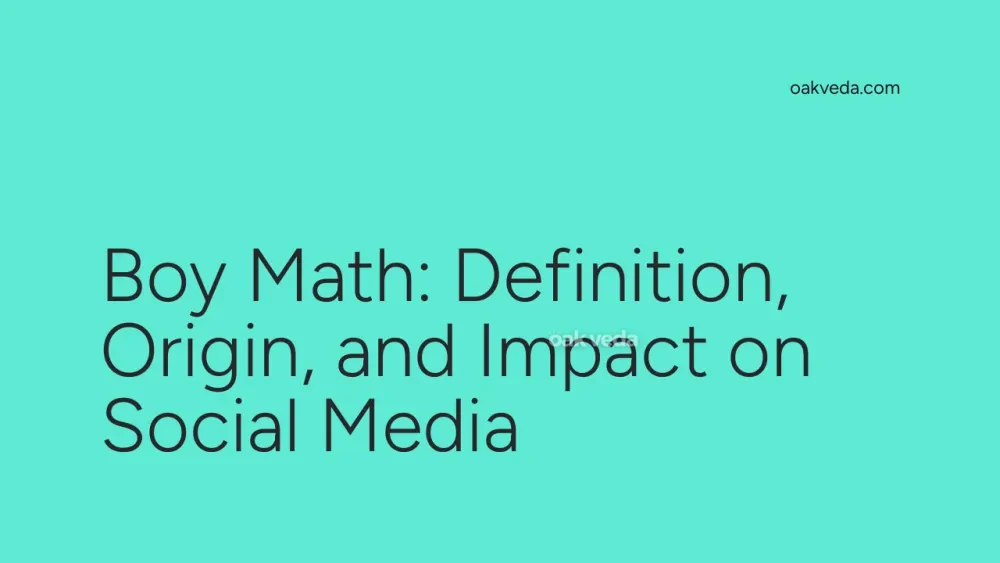
What is Boy Math?
Boy math is a viral social media trend that emerged as a humorous commentary on male logic and behavior. This phenomenon gained traction as a counterpart to the earlier "girl math" trend, which playfully justified women's spending habits. Boy math, however, takes a more satirical approach, often highlighting and critiquing male stereotypes and behaviors.
Origin and Development of Boy Math
The boy math trend originated on popular social media platforms like TikTok and Twitter (now X) in response to the widespread girl math phenomenon. While girl math focused primarily on lighthearted jokes about financial decisions, boy math evolved to address a broader range of male-associated behaviors and thought patterns.
As the trend gained momentum, it became a vehicle for social commentary, often used to challenge gender stereotypes and spark discussions about societal expectations placed on men.
How Boy Math Works
Boy math operates by presenting exaggerated or illogical statements that humorously critique common male behaviors or thought processes. These statements often follow a format that highlights the perceived inconsistency or absurdity in certain male-associated actions or beliefs.
For example, a typical boy math statement might be:
- "Boy math is saying you're 6 feet tall when you're actually 5'10"."
- "Boy math is being afraid of gold diggers when you don't have any gold to dig."
These statements serve to both entertain and provoke thought about gender roles and societal expectations.
Popular Examples of Boy Math
Some popular examples of boy math that have circulated on social media include:
- "Boy math is adding 2 inches to everything they measure."
- "Boy math is spending $500 on car parts but refusing to pay for a $50 dinner date."
- "Boy math is saying 'I'm on my way' when they haven't even left the house yet."
- "Boy math is having a 'high body count' but slut-shaming women who do the same."
These examples showcase how boy math is used to highlight perceived double standards or irrational behaviors often associated with men in popular culture.
Impact of Boy Math on Social Media Culture
Boy math has had a significant impact on social media discourse, particularly in discussions about gender roles and stereotypes. Unlike its predecessor, girl math, which was generally perceived as lighthearted and fun, boy math often takes on a more critical tone.
The trend has:
- Sparked conversations about male behavior and societal expectations
- Encouraged self-reflection among male social media users
- Provided a platform for discussing gender issues in a relatable, often humorous way
- Challenged traditional notions of masculinity and male privilege
Controversies Surrounding Boy Math
While boy math has gained popularity, it has also stirred controversy. Some critics argue that the trend:
- Promotes negative stereotypes about men
- Oversimplifies complex gender issues
- Can be perceived as reverse sexism
Supporters, however, contend that boy math serves as a necessary counterbalance to the often unchallenged stereotypes about women and provides a space for critical discussion about gender norms.
How Brands and Influencers Use Boy Math
Savvy brands and influencers have capitalized on the boy math trend to engage with their audiences and spark conversations. They use the format to:
- Create relatable content that resonates with their followers
- Address gender-related issues in their industries
- Promote products or services in a humorous, trend-aware manner
- Encourage audience participation through user-generated content challenges
For example, a men's grooming brand might use boy math to highlight the importance of self-care, or a dating app could use it to promote healthy relationship habits.
Future Trends Related to Boy Math
As social media continues to evolve, so too will trends like boy math. We can expect to see:
- More nuanced discussions about gender roles and expectations
- The emergence of similar trends addressing other demographic groups
- Integration of boy math concepts into broader social commentary
- Potential backlash or counter-trends as the discourse develops
The longevity of boy math as a trend will likely depend on its ability to adapt and remain relevant in the fast-paced world of social media.
FAQs about Boy Math
Q: Is boy math only used by women to criticize men? A: No, people of all genders use boy math. Many men participate in the trend, often in a self-deprecating or reflective manner.
Q: Can boy math be considered offensive? A: Like many internet trends, boy math can be controversial. While some find it humorous and insightful, others may perceive it as promoting negative stereotypes.
Q: How is boy math different from girl math? A: Girl math typically focuses on justifying spending habits, while boy math addresses a wider range of behaviors and often takes a more critical tone.
Q: Is boy math exclusive to certain social media platforms? A: While boy math gained popularity on TikTok and Twitter, it has spread across various social media platforms, including Instagram and Facebook.
In conclusion, boy math has emerged as a significant social media trend that goes beyond mere entertainment. It serves as a mirror to society, reflecting and challenging our perceptions of gender roles and behaviors. As with any trend, its true impact will be measured by the conversations it starts and the changes it inspires in how we think about and discuss gender in the digital age.
You may be interested in:
- FR (For Real): Definition, Origin, and Impact on Social Media
- Finna: Definition, Origin, and Impact on Social Media
- Social Selling: Definition, Origin, and Impact
- Media Library: Definition, Origin, and Impact on Social Media
- Girlie: Definition, Origin, and Impact on Social Media
- Archiving on Social Media: Definition, Origin, and Impact

